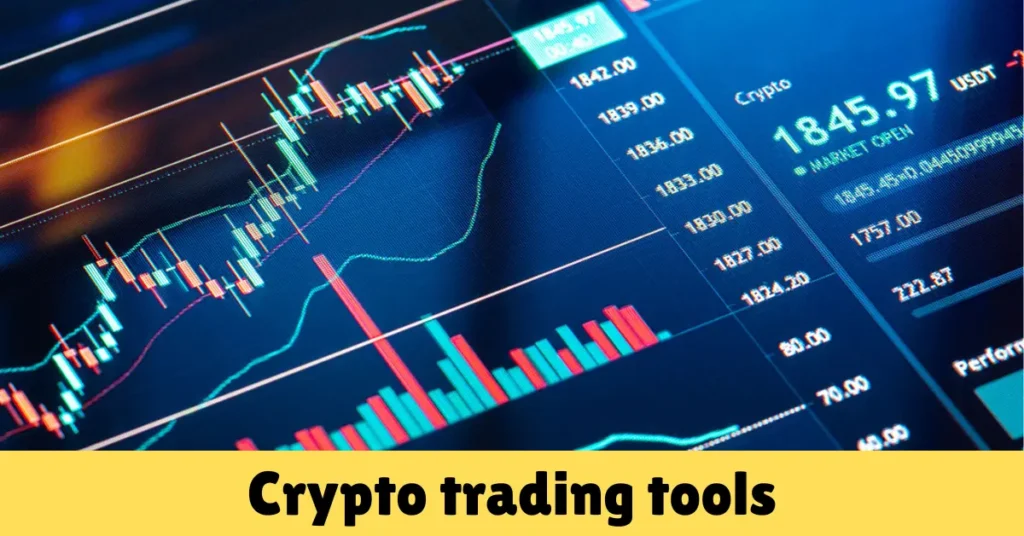Crypto trading tools
Introduction
Crypto trading has become one of the most popular ways for people to invest and earn money online. With thousands of cryptocurrencies available and markets that run 24/7, it can feel exciting but also a bit overwhelming.
That’s where crypto trading tools come in.
Whether you’re just getting started or already trading, these tools can help you make better decisions, track market trends, manage your risks, and even automate your trades. In short, they make your trading journey smarter and smoother.
In this blog, we’ll break down what crypto trading tools are, the different types available, and how they can help you trade more effectively. If you’ve ever wondered how traders keep up with such a fast-moving market this is the guide for you.
Understanding Crypto Trading
Before we talk about crypto trading tools, it’s important to understand what crypto trading actually means.
Crypto trading is the process of buying and selling cryptocurrencies like Bitcoin, Ethereum, and others to make a profit. Just like people trade stocks in the stock market, crypto traders buy coins at a lower price and sell them at a higher price.
But unlike the stock market, the crypto market is open 24/7, which means trading never stops. Prices can rise or fall at any time, even in the middle of the night. This makes crypto trading exciting — but also very risky.
There are different styles of trading:
- Day trading: Buying and selling within the same day.
- Swing trading: Holding for a few days or weeks based on market trends.
- Long-term investing: Holding crypto for months or years.
To be successful in crypto trading, you need more than just luck. You need information, timing, and strategy and that’s where trading tools become extremely useful.
What Are Crypto Trading Tools?
Crypto trading tools are software, platforms, or apps that help traders make smarter decisions in the crypto market. These tools don’t trade for you (unless they’re bots), but they give you useful information, insights, and features to improve your trading skills and reduce risk.
Think of them as your personal assistants for trading. They help you:
- Watch price movements in real time
- Analyze charts and patterns
- Track your profits and losses
- Set up alerts for market changes
- Even automate trades while you sleep
With the crypto market being so fast and unpredictable, it’s almost impossible to trade effectively without using at least a few of these tools. The good news is there are many tools available for all levels, from beginners to experts.
Types of Crypto Trading Tools
There are many types of crypto trading tools available, and each one serves a different purpose. Some help you read charts, some help you manage your portfolio, and others can even trade for you. Let’s take a look at the most popular types:
a. Charting Platforms
These tools help you analyze price charts and spot trading opportunities. They provide indicators, drawing tools, and market data to help you understand where the price might go next.
Popular examples:
- TradingView
- Coinigy
These platforms are great for technical analysis, which is the study of price trends and patterns.
b. Crypto Market Aggregators
These websites or apps collect data from different crypto exchanges so you can easily compare prices, volume, and market trends in one place.
Popular examples:
- CoinMarketCap
- CoinGecko
They’re useful for checking which coins are gaining or losing value and keeping track of overall market health.
c. Portfolio Trackers
As you start trading more coins, it becomes hard to keep track of your investments. Portfolio trackers help you monitor your profits, losses, and the current value of your holdings.
Popular examples:
- Blockfolio (now FTX App)
- Delta
These apps save you time and make sure you always know where you stand financially.
d. Trading Bots
Trading bots are automated programs that can buy and sell crypto based on the rules you set. They can trade for you 24/7 and are especially useful for people who don’t want to monitor the market all the time.
Popular examples:
- 3Commas
- Pionex
While bots can be helpful, they still need good strategies behind them.
e. On-Chain Analysis Tools
These tools look at data directly from the blockchain to give you insights into investor behavior, wallet activity, and network health.
Popular examples:
- Glassnode
- Santiment
They help you understand what big players (also known as whales) are doing and how that might affect prices.
f. Risk Management Tools
These tools help protect your money. They include features like stop-loss orders, take-profit levels, and position size calculators. They help you manage how much you risk in each trade so you don’t lose more than you can afford.
Each of these tools serves a different purpose, and many traders use a combination of them to get the best results.
How to Choose the Right Crypto Trading Tools
With so many crypto trading tools available, it can be confusing to know which ones to use — especially if you’re just getting started. The good news is, you don’t need them all. You just need the right ones that match your trading style and goals.
Here are some tips to help you choose the right tools:
Know Your Trading Style
First, ask yourself:
- Are you a day trader, a swing trader, or a long-term investor?
- Day traders need fast, real-time data and advanced charting tools.
- Swing traders might want tools that help with trend analysis and risk management.
- Long-term investors may focus more on portfolio trackers and on-chain analysis.
Start with the Basics
If you’re new to trading, begin with a charting platform and a portfolio tracker. These are easy to use and give you a solid foundation to learn from.
Check User Experience
Choose tools that are easy to navigate, have a clean design, and offer helpful tutorials or customer support. You don’t want to waste time trying to figure out how a tool works.
Look for Useful Features
Make sure the tool has the features you actually need. For example:
- Alerts for price changes
- Integration with your favorite exchange
- Risk management settings
- Mobile access (if you trade on the go)
Read Reviews and Compare Options
Before signing up, read user reviews or watch YouTube videos to see what others think. Many tools also offer free trials, so you can test them out before committing.
Stay Within Budget
Some tools are free, while others have monthly fees. As a beginner, you don’t need expensive tools. Start with free or low-cost options and upgrade later if needed.
Common Mistakes to Avoid When Using Trading Tools
Crypto trading tools can be powerful, but they’re not magic. A lot of beginners make mistakes by using them the wrong way or depending on them too much. Here are some common mistakes to avoid:
Relying Only on Tools Without Learning the Basics
- Many new traders jump into tools without understanding how trading works. No matter how advanced a tool is, it won’t help if you don’t know how to use the information it gives.
- Tip: Learn basic trading concepts first, then use tools to support your strategy.
Trusting Trading Bots Without Proper Settings
- Bots can automate your trades, but they need the right strategy and settings. If you just turn them on without understanding how they work, you could lose money quickly.
- Tip: Test your bot settings on a demo account before using real funds.
Ignoring Risk Management Features
- Some traders forget to set stop-loss or take-profit levels, even when their tools support it. This can lead to bigger losses than expected.
- Tip: Always use risk management tools to protect your investment.
Using Too Many Tools at Once
- Trying to use every tool out there can lead to information overload. You might feel more confused than confident.
- Tip: Start with a few essential tools and add more only when you need them.
Following Signals Blindly
- Some tools or platforms give buy/sell signals. These might seem helpful, but they’re not always accurate.
- Tip: Use signals as a guide, not a rule. Always do your own research.
Avoiding these common mistakes will help you get the most out of your trading tools — and protect your money at the same time.
Types of Crypto Trading Tools
1. Charting Platforms
- TradingView
- Coinigy
- CryptoCompare
- Binance Charting Tools
2. Crypto Market Aggregators
- CoinMarketCap
- CoinGecko
- LiveCoinWatch
- Nomics
3. Portfolio Trackers
- Blockfolio (FTX App)
- Delta
- CoinStats
- Zerion
4. Trading Bots
- 3Commas
- Pionex
- Cryptohopper
- Bitsgap
5. On-Chain Analysis Tools
- Glassnode
- Santiment
- Nansen
- IntoTheBlock
6. Risk Management Tools
- Trailing Stop Loss Tools (built into exchanges like Binance)
- Position Size Calculators (available on many trading websites)
- Stop-Loss/Take-Profit Order Features (offered by most crypto exchanges)
Frequently Asked Questions (FAQs)
Do I need crypto trading tools as a beginner?
Yes, but you don’t need all of them right away. Start with basic tools like a charting platform and a portfolio tracker. These will help you understand the market better and keep track of your trades.
Are crypto trading tools free?
Some tools are completely free, while others offer premium features for a monthly fee. Many paid tools also offer free trials, so you can test them before deciding.
Can trading tools guarantee profits?
No, trading tools can’t guarantee profits. They are meant to help you make better decisions, but success also depends on your knowledge, strategy, and risk management.
What is the safest trading tool to use?
Safety depends on how you use the tool. Choose tools with good reviews, secure connections, and transparent pricing. Avoid tools that ask for full access to your exchange accounts unless you fully trust them.
Are trading bots good for beginners?
Trading bots can be helpful, but they’re not ideal for beginners without experience. You need to understand trading strategies before setting up a bot. Otherwise, it might do more harm than good.
Can I use these tools on my phone?
Yes, many trading tools offer mobile apps or mobile-friendly websites, so you can trade and monitor the market on the go.
How do I know which tool is best for me?
Start by identifying your trading style (day trader, long-term holder, etc.). Then choose tools that match your needs. Don’t be afraid to try a few before settling on the ones that work best for you.
Conclusion
Crypto trading tools are a great way to make your trading journey easier, smarter, and more organized. Whether you’re checking charts, tracking your portfolio, or using a bot, the right tools can save you time and help you make better decisions.
Start simple, learn as you go, and always remember — tools are there to support your strategy, not replace it.
Bonus Tips for Using Crypto Trading Tools
Keep Learning
- Crypto markets change fast. Stay updated with news, tutorials, and new features in the tools you use.
Use Demo Accounts
- Before trading with real money, test your tools and strategies using demo or paper trading accounts. It’s a risk-free way to practice.
Don’t Ignore Security
- Always use tools that offer two-factor authentication (2FA) and avoid giving full access to your crypto wallets unless absolutely necessary.
Track Your Progress
- Review your trades regularly to see what worked and what didn’t. Some tools even provide performance reports to help you learn from your past trades.
Join Communities
- Follow trading communities on platforms like Reddit, Twitter, or Discord. You can learn a lot from other traders’ experiences and tool recommendations.
Also read
- What is a Crypto Wallet and How Does It Work? – Coinsify
- 10 Crypto Terms Every Beginner Must Know – Coinsify
- What is Blockchain Technology – Complete Guide – Coinsify
- How to Buy Crypto Safely in 2025 – Complete Guide – Coinsify
- Bitcoin vs Ethereum: Key Differences Explained – Complete Guide
- Ultimate Blockchain Glossary: Learn Blockchain Terms Easily
- How to Buy Bitcoin Safely (Complete Beginner’s Guide)
- Top 10 Crypto Wallets for Beginners (2025 Edition)
- What is Cryptocurrency? A Beginner-Friendly Guide (2025)






